
I have a sneaking suspicion that it really doesn’t matter what I’m writing right now since none of you are likely to be reading this text. The picture above is sensory overload, plain and simple. I saw it in person and I still don’t believe it, so I’ll give you a few minutes to stare, wipe the drool off your keyboard, save the photo to your hard drive and subsequently upload it to your tumblr… then we can start this article when you’re good and ready.

I don’t mean to sound cocky, but it’s pretty hard not to like this car. It’s a perfect blend of form and function, with timeless good looks and shiny new power adders. There’s just something about a 911 that stops people in their tracks, car fanatics and regular folks alike. When you add some crazy looking exposed custom turbo setup it’s like the car is forcing itself down your throat, only content when it owns your heart completely.

But as easy as it is to like this car based solely upon curb appeal, the story behind the car makes it even more charming. To Honda enthusiasts the name ‘Bisi Ezerioha needs no introduction. If I even began to attempt to recall all the records ‘Bisi set, broke or still holds in FWD sport compact drag racing it would likely be enough to complete the rest of the text for this article. He’s built a reputation for doing things differently, things others are afraid of.

Ironically his boost to fame within the Honda scene came from his ability to break records with his ludicrous NA builds. He went against the grain powering his cars not with the DOHC B- and later K-series engines of his rivals, but rather opting for Hondas simpler, and considerably cheaper, SOHC engines. To add insult to injury, he was using super uncool non-VTEC variants, building them to the extreme and then wiping the floor clean at the drags.

In more recent years ‘Bisi has begun carving out a second niche for himself in the turbo market, starting with a crazy 700whp 1.6L single-cam Civic shuttle. He has also applied this technology to a partnership with American Honda building vehicles for SEMA, starting with the most powerful CR-Z in the world, which was followed by a 1004whp 2012 Civic Si.

When he’s not building monster demo cars he’s running his business, aptly named Bisimoto. Although ‘Bisi is capable of performing a wide range of services, one his most popular is dyno tuning. He’s built quite the reputation as a tuner and is one of the foremost experts when it comes to AEM EMS boxes.
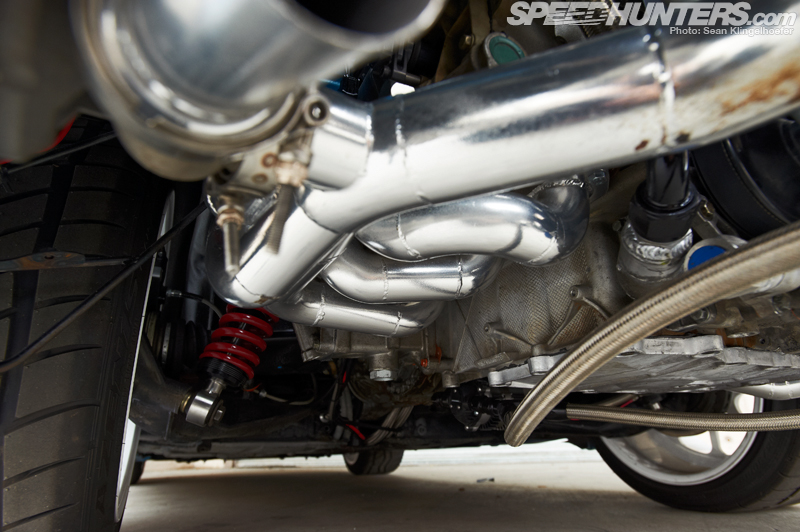
In addition to tuning and engine building services Bisimoto also offer a full line of components including camshafts, cam gears, connecting rods, valve train and more. Undoubtedly their best known product are their long-tube headers, a part that has been proven time and again to have no equal. With an ever growing hunger to explore new avenues for progress ‘Bisi has decided to take all of this technology to a new brand…

Porsche. And so once again ‘Bisi will attempt to carve out yet another niche for the Bisimoto brand, the only question is how it will be received by the already established and opinionated Porsche crowd. I’ve known ‘Bisi for many years now collaborating on countless stories together and if there’s anything I’ve learned about this man it’s that his work ethic and commitment to greatness is something I’ve seldom seen in others.
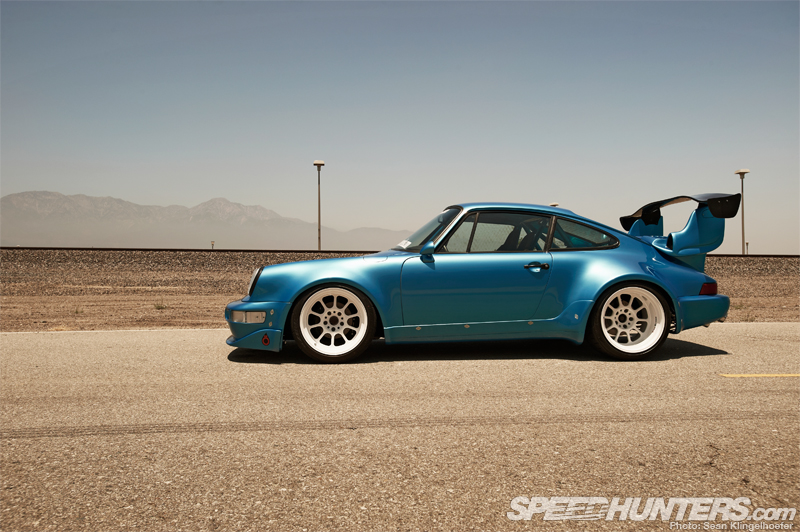
So it is with this car, a 1976 911, that ‘Bisi first dipped his toes into exciting world of Porsche. As he tells me he had many talks with his dyno customers who were more and more frequently tuning for road racing and they began to suggest that ‘Bisi take his expertise over to boxer engines from Stuttgart. He admits always having loved the shape of 930s, so he eventually purchased this car and completely stripped it down.

Next all of the planned modifications were tediously jotted down and some initial goals were set. Quickly realized was that fact that in order to reliably obtain the kind of power he was looking for and maintain drive ablility, the air cooled flat six that came with the car wasn’t going to cut it. With the help of some friends he was able to source a reasonably priced 996 engine and then he “did what I always do” ‘Bisi tells me “and swapped it.”
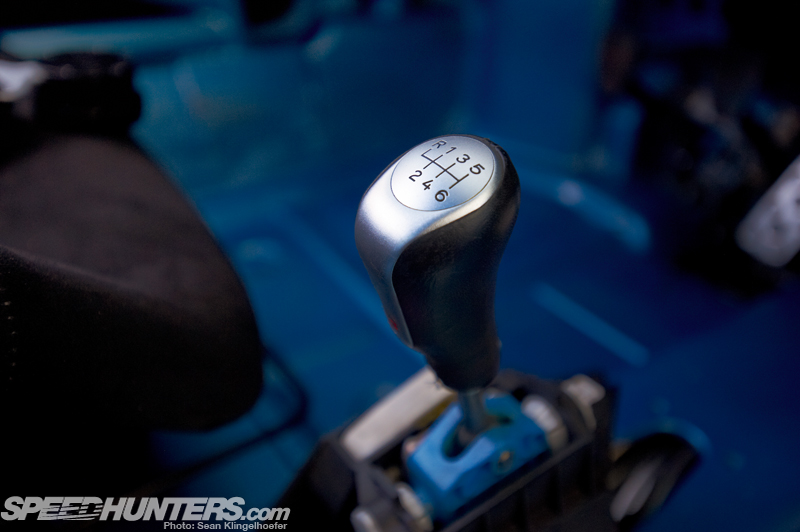
Along with the new power plant a 997 6-speed gearbox was sourced and bolted to the 3.4L. These updates alone would be enough to turn the featherweight ’76 into a pretty impressive performer. Needless to say for a man who has built a name for creating the insane, a simple engine swap wasn’t going to be enough.

He knew he wanted to build some serious power via a pair of turbochargers, but in order to get there reliably there was work to be done inside the engine first. Doing what he does best, ‘Bisi stripped down the engine, examined the components, developed new custom parts and rebuilt it with surgical precision.

While stuffing a motor full of radical new internals is important to engine longevity, there was more than just the rebuild required for this conversion. In the front ‘Bisi has built a custom radiator setup with ducting from the front bumper feeding air to a shroud which then forces the charge through the radiator where it then cools the core before being expelled under the car.

With the important stuff attended to ‘Bisi could then get on the fun part, mounting and plumbing the Turbonetics turbochargers. I am told that this is actually the third development configuration with the smallest turbos of the lot, but produces the most usable power. The initial setup called upon two significantly larger snails to bring power up around the 1400 mark, but the lag was unbearable. To solve this the turbos were reduced to 61mm units which, at around 11psi, make a “modest” but very usable 648whp.

While the shiny turbochargers gleaming through the void in the rear bumper steal the show, they are but a single piece of the puzzle. To keep the engine happy under all boost conditions the car also utilizes a Turbonetics Godzilla blow-off valve and a pair of RG-45 wastegates which dump just below the exhaust, giving the car a uniquely staggered quad exhaust look.

As one might imagine, supplying the fuel demand of such an engine is also quite a serious job. A Holly Dominator pump extracts fuel from the custom built aluminum fuel cell and pushes it through stainless lines past a series of Kinsler filters before reaching the fuel rails where it is pressurized and sent through custom Bisimoto 1000cc injectors. The fuel setup, like the rest of the car, is meticulous.

Surrounded on all sides by fuel lines is a lone AEM boost solenoid, which feeds signals directly to the AEM EMS computer.
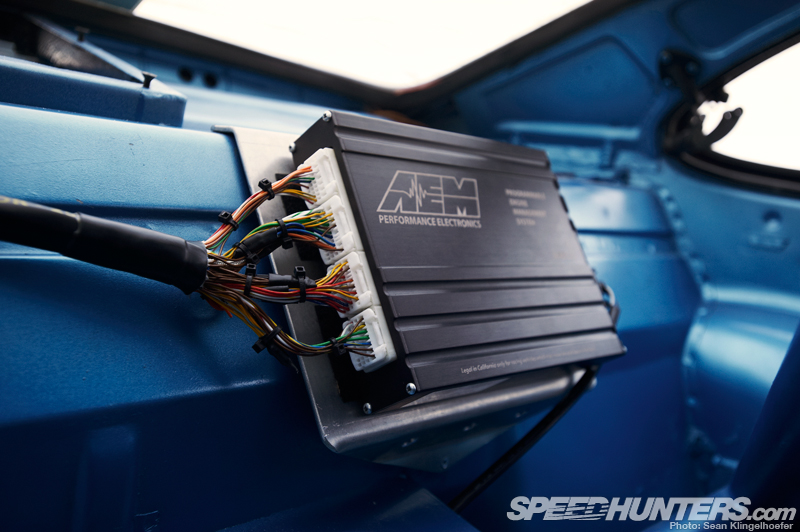
This little black box controls a myriad of parameters, each of which have been custom defined by ‘Bisi himself. This is, as far as I know, the first time anyone has operated a Porsche with one of these computers. With the EMS and ‘Bisi’s familiarity with it comes almost unlimited possibility.

From what I could tell the computer, although fully customizable, was designed for a Honda V6 so it should come as no surprise that ‘Bisi has enlisted the help of Honda wiring guru Ryan Basseri to create a bespoke harness for this Porsche. Virtually the entire car, from the front-mounted multiplex which replaces the fuse box to the engine-mounted sensors in the rear, has been rewired from scratch.

To take full advantage of the ECU’s capabilities an AEM throttle-by-wire system has also been installed. This enables ‘Bisi to create different throttle curves, for example one for economy, one for spirited drives and a full on track tune. He can also use this piece of technology to create smooth traction control settings.

To adjust traction control ‘Bisi has mounted this piece of fighter jet surplus to the dashboard. The pitch angle dial now controls the TC gain.

Sitting just a few binnacles over is an AEM digital gauge which has cleverly found its way inside the factory bezel for a stealth look. From here the driver can see virtually any parameter that the ECU monitors at the push of a button. Immediately adjacent to this is a custom VDO Bisimoto tachometer, unquestionably less complex but equally as important to the drive.
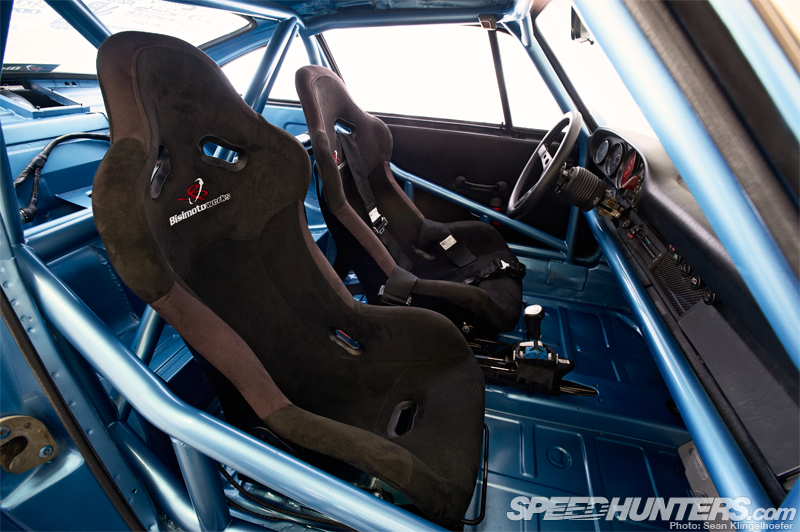
Other Bisimoto branded items include a pair of racing bucket seats which keep the driver and passenger firmly planted inside the perimeter of the Steen Chassis NASA spec rollcage.

Outside the car is sporting a set of Eins Gramm wheels, another Bisimoto original. Eighteen inches in diameter and eleven inches wide up front, thirteen out back, these wheels are the perfect match to the aesthetic of the exterior. They are wide enough to evoke a sense of performance but still fit inside the fender arches in a tidy manner.

Somehow ‘Bisi has figured out a way to create a car that is subtle and aggressive in equal parts. A custom Bisimoto spec front bumper, rocker panels and rear bumper have been attached to the body via quarter-turn fasteners. The paint is a hue called Bisimoto Electric blue and is the trademark of Ezerioha’s builds.

Keeping the rear end planted is a massive carbon fiber spoiler that track day Porsche enthusiasts lovingly call “the banana wing”. In addition to the louvers which aid the intercooler, the uprights also feature inlets which create a ram-air intake effectively channeling air moving across the top of the rear fenders into the engine compartment where it can be consumed by the turbos.
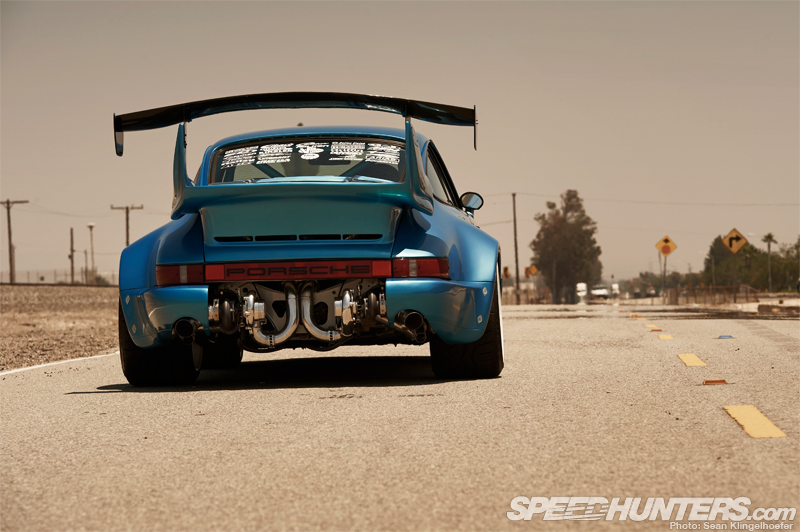
Ironically ‘Bisi admits that aesthetics are his weakest area in terms of car building, but how could you not like this? Letting the performance speak for itself, both metaphorically and in this case visually, has become the aesthetic.

It’s one that is quite flattering, wouldn’t you agree? I have no doubt that this monster will be very difficult for the Porsche world to ignore and it’s only a matter of time before Bisimoto converts an entirely new group of car enthusiasts into believers.

With two more crazy demo Porsches on the way with another personal 911 waiting in the wings you can rest assured this won’t be the last monster flat six we see from Bisimoto. I wish ‘Bisi, one of the hardest working and nicest, not to mention well spoken, men I have ever met nothing but luck. I’ll be anxiously waiting to see what he does next.
Bisimoto 1976 Porsche 911
ENGINE
Bisimoto built 3.4L M96 engine; Bisimoto steel rods, heat shielding intake gasket, drive-by-wire 82mm throttle body, custom headwork, custom aluminum fuel cell; Bisimoto spec 1000cc high impedance injectors; Bisimoto web level 2.4 camshafts; Arias 9:1 forged pistons with ceramic coated tops and moly coated skirts; high output smart ignition coils; K&N oil filter; NGK Iridium spark plugs; Purol lubricants (10w-40 engine); custom Bisimoto JNF exhaust manifold; custom Turbonetics 61mm billet turbochargers (x2), Godzilla blow-off valve, RG-45 wastegates (x2); Burns Stainless exhaust piping and hardware; custom Spearco air-to-air intercooler; Driftmotion 2.5” aluminum piping; Golden Eagle sleeved engine cases; custom Bisimoto-spec intake manifold; Griffin dual-pass radiator with shroud; Supertech stainless steel intake and Inconel exhaust valves; Vibrant Vanjen clamps and stainless hardware; Holley dominator billet fuel pump; Kinsler fuel rail, 100 and 25 micron fuel filters; G&J braided fuel and oil lines; ARP head studs; RSR engine mounts; VP Racing 100 octane unleaded fuel
ENGINE MANAGEMENT / ELECTRONICS
AEM Series 2 EMS with custom drive by wire control, AEM 5 bar MAP sensor, oil pressure sensor, electronic boost control solenoid
DRIVELINE
997 six speed gearbox; Bisimoto-spec Action 2MS Clutch
SUSPENSION / CHASSIS
Steen NASA spec Chromoly roll cage; Bisimoto-Eibach full coilover suspension
BRAKES
Custom 996 derived brake kit
WHEELS / TIRES
Grand Prix white Eins Gramm aluminum wheels 18×11 (F), 18×13 (rear); Falken Azenis RT-615K tires 265/35R-18 (F), 315/30R-18 (R)
CABIN
Bisimotowerks racing seats, 11,000 rpm tachometer with shift light, fighter special gauge fit control box; Odyssey ER35MJ dry cell battery; Rywire mil-spec harness with low resistance bulkheads; Rueda interior paint; Rennline foot plates, steering release, batter box; Prototipo steering wheel; RS door panels; Porsche 997 shift knob
BODY
Bisimoto Electric Blue paint; Type 2 graphics stickers; Bisimoto splitter infused front bumper, rear bumper, side skirts, GT-X trunk wing; Dzus fasteners; Carbon Creations GT concept 1 top wing
More stories by Sean Klingelhoefer on Speedhunters
More car features on Speedhunters
More Porsche stories on Speedhunters
– Sean














Amazing build! Is there any video of this car so I can hear that engine?
Rauh who? LoL - joke - but seriously
Watch and learn RWB, this is how a Porsche should look and drive!
http://www.youtube.com/watch?v=rZGG5miZi2c here u go! sick ass car.
MEIN GOTT
does he normally have filters or screens over those turbos or are they always open like that? looks like it wouldnt be too hard for one to suck in a small rock or piece of road debris being so close to the ground.
@Hanma Yes when he drives the car there are filters over the turbos like the ones you see in the dyno video below. They just look so incredible open for photos.
@KietaPhillips Moik already got you covered!
People had to bring RWB into this... So many idiots fighting this imaginary war of 'who knows best'. I'm sure RWB, and the people that built the Porsche above don't give a sh*t... I don't, and millions of others don't either-- because it doesn't matter.
holy balls
Awesome whip, btw! Thanks, Sean.
This is Goddamn incredible. Thank you, Sean!
@Hanma I was going to say... unprotected intakes make me anxious haha
Sean,
Great article! Nice work!!!!
If I saw that in-front of me at the lights, I'd open the windows to hear it when it went It's just sick.
It's just sick.
actually not as loud as I thought it would be...
Those "super uncool non-VTEC variants" happen to be the strongest Honda SOHC motors.
awesome....!
can anyone tell me, whats the difference between a waste-gate and a blow of valve? i always thought that they were the same thing!!
i love reading your texts (:
lovely write up btw
@Nikhil_P A blow off valve is used to get rid of excess air before it reaches the intake manifold, as you can imagine air is travelling to the intake manifold the whole time you are on the throttle, when you get off the throttle the throttle body closes and the air needs to escape, the blow off valve opens and lets all the air out, this is why you hear the noise whenever someone changes gear/gets off the throttle, it is the air leaving the intake of the car out of the blow off valve.
A wastegate controls the air going through the turbo into the intake, if you want to run 18psi, the spring in the wastegate will open at 18psi and all extra air will go through the wastegate and leave the car through your exhaust system or to the atmosphere (depending on how you have it setup)
@sean klingelhoefer Koo! Thanks!
@astorey @Nikhil_P Exactly, the wastegate controls boost pressure by diverting exhaust, blow off valve releases pressure from the intake side when the throttle is closed.
@Nikhil_P waste gates regulate the ammount of exhaust gasses that get passed through the turbo.those second pipes you see next to the exhaust are were those gasses are vented out of. this is what controls your boost levels. a bov is between the throttle body and turbo intake. this releases the built up pressure between the turbo and closed throttle body to prevent the air from surging back through the turbo and causing any damage.
@apex_DNA Absolutely, by saying "super uncool" I'm simply referring to how typical Honda enthusiasts view the engines. With several builds of over 17:1 compression I think 'Bisi has proven beyond any doubt just how indestructible these engines can be.
@Hedi211 Thanks Hedi, it was nice seeing you again!
Awesome, thanks!
give that b**** an RWB kit
b****es love RWB kit.
61" turbo chargers huh? I think you meant millimeters Speed Hunters. Hard to see those 5 foot wide turbos guys heh heh heh...
@Guest Wow I guess that's what happens when you write a story at 4am! Good spot.
@Option86
Exactly. Bisi vs RWB is like apples vs oranges.
Nice bit of kit. Good to see Bisi broadening his horizons. I wonder why Bisi didnt follow the turbo arrangement used on the 935's?
TRUTH
yeah, RWB is hella hip and cool these days <3
any chance of videos??
awesome write up on an unbelievable car , i love it!!!
@scibO see below
Holy sh!t
Been following Bisimoto on facebook and seen some pics of this a little while back, but this was a great write up with some fantastic pictures. RWB, watch out..
Bisi is a genius. Simple as that
Bisimoto engineering is a wrong name,
Bisimoto ground-flying industry is much more proper...
One piece of debris in one of those turbines and it will do detrimental damage. Needs some protection, Especially with them located where they are.
I like how the spec sheet mentions the fuel filter specs, but no air filter is mentioned or pictured. What's with the hate for clean air?
@s13dan Right... which is why he puts filters on them when he drives, as mentioned below.
@Option13 There's no hate, the car does use a pair of Vibrant air filters when it's not sitting still for pictures.
wheres the video???
ya wheres the video xD
A car must have an air filter.
A car must have an air filter.
@TougeBattle look below...
@TougeBattle look below...
Two awesome things I noticed:
1. A "modest" 600hp.... 600 FiretrUCKING HORSEPOWER BABY!!!!
2. The tachometer is completely red. Therefore, you will be hitting the redline at all times for MAXIMUM SPEEEEED!!! Hahaha!!
Two awesome things I noticed:
1. A "modest" 600hp.... 600 FiretrUCKING HORSEPOWER BABY!!!!
2. The tachometer is completely red. Therefore, you will be hitting the redline at all times for MAXIMUM SPEEEEED!!! Hahaha!!
Bisi and Nakai-san need to get together and make a Bisimoto/RWB love child. That would be the end-all, be-all!!!
Bisi and Nakai-san need to get together and make a Bisimoto/RWB love child. That would be the end-all, be-all!!!
@Corey K RWBisi!
Great Article, this is what brings me to Speedhunters.com!
This is the ultimate in cool old school Porsches!!! Great work Bisi! Love it!!! o_O
Thanks for this article, awesome work.
I'm a little bit sad that it's water cooled, but EVERYTHING else makes up for it just a little bit hahahaha
@HeathvanderWaerden I think in the long run it was the right decision, but I know what you mean.
I had no idea this is what Bisi has in mind for his next gig and it is a glorious thing, congrats to him! Lovely car and so much style involved with letting the upgrades speak for themselves visually. Ace in the hole Sir, very nice work!
If only his "custom headers" were as nice and custom as this car lmao fuck this fake ass guy!
Why does this thing not have air filters? What if it sucks in some road kill? Or your beard?
Why does this thing not have air filters? What if it sucks in some road kill? Or your beard?
@Nikhil_P A wastegate is a boost "control" mechanism on the hot-side of the Turbo while a BOV (or Dump Valve) is a cold-side inlet pressure release valve used for protection/pressure release.
The wastegate can be can be part of the casing of a turbo or it can be divorced from the case (separate) this allows you to control a larger range of boosts depending on the application by sitting a larger/smaller wastegate. By bypassing gas from the hot-side compressor wheel you limit the pressure on the cold side due to controlling the RPM of the compressor... controlling boost.
On the other hand the BOV is used to stop cold-side turbo compressor back-pressure... it will release this pressure or recirculate it depending on what type of setup you select.
i.e. Lets say your on boost hard and you suddenly come off the throttle, What happens is the butterfly valve in the Air intake closes but the turbo is still spinning at a High RPM and stilling moving a large volume of air (some of this is caused by gases still exiting the engine)... this will cause a pressure spike between to cold-side outlet of the turbo and the butterfly valve of the intake. The Air has no escape and is forced back into the Turbo (resulting in a chattering tu-tu-tu-tu)... Now it's debated if this causes premature failure of a Turbo but that's another matter, the air slows down the Turbo due to it forcing back on the compressor wheel... (this actually slows the wheel unspooling the turbo). So the purpose of the Dump/BOV is once the butterfly closes creating a vacuum condition on the engine side of the butterfly, it actually opens the BOV and allows that intake pressure to release.
DUMP = Pressure Protection
Wastegate = Boost Control.
Hope this helps.
Wow, very nice. I work with Porsches all day and have seen some serious builds, and although this is definitely not the most elegant setup I've ever seen, its definitely a VERY nice one!
I'll definitely be keeping an eye out for what 'Bisi comes out with next!
@sean klingelhoefer Please do desktops of #2 and #5... Pretty please haha
ohhh, thanks guys!!! did not know that!!! But now i do!
I want one.
To the author = Solenoids are controlled by the ECU (ECU feeds it), Sensors feed into the ECU.
RWD doesnt work on engines or performance, its a body shop. Bisi said the worst part of his build is the looks. I dont see why taking a car with awesome performance and not so awesome looks (his words not mine, i think it looks perfect) and mixing it with one of the most agressive porsche bodykits would ever be a bad thing. Would be cool if bisi brought his creation to the US distributer and installer of RWB kits (forgot who or where its done) and got his monster looking as bad (the good kind of "bad") as its engine/chassis setup is.
I guess having a badass looking, sounding, and driving car would be too "hip" for some people.
@Larry Chen defeats the purpose of high input turbo. filter = resistance
+1 !
In hermetic and most semi-hermetic compressors, the compressor and motor driving the compressor are integrated, and operate within the pressurized gas envelope of the system. The motor is designed to operate and be cooled by the gas or vapour being compressed.
Bisi' does it yet again. I look up to this guy and ultimately respect him as a tuner
I would of loved to see this beast with the 1400 horsepower it had, even though not usable, it would be incredible to see it at a standing mile competition. Great work bisi as always